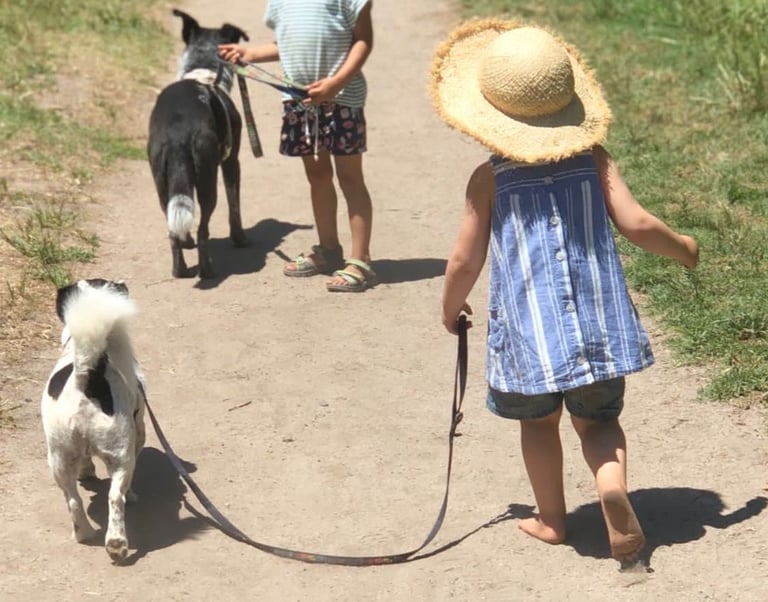Prepare your dog for baby’s arrival
Tips on how you can set up your dog and yourself for success for the big day
7/31/20254 min read


Pepare your dog for baby’s arrival
The arrival of a baby is such a wonderful moment. For many months we excitedly plan and prepare ourselves, make way for changes in our lives, homes and routines. For our dogs it can seem however that the new family member has just arrived overnight without any warning. But there are ways you can make this change a happier one for your dog as well.
While some dogs might handle the changes that come with the arrival of a new family member with more ease, it is usually quite a challenging situation for most dogs. Dogs love routines, and these tend to get changed quite dramatically when the freshly baked parents’ lifestyle changes. Less attention, shorter walks, being restricted form access to certain parts of the house, loud noises (such as baby crying) and many other aspects can cause a dog to feel stressed or even see the baby as competition for attention.
Here are some tips on how you can set up your dog and yourself for success for when the big day arrives. If you are a pet parent too, chances are you are looking forward to your dog and child developing a very special bond, so let’s make sure they’re off to a good start!
The most important advice is: Don’t start a week before the baby arrives - take at least 3 months to prepare your dog.
o Training your dog basic skills
If this means brushing up on what your dog already knows at home or starting from scratch with dog training classes: take the time to train your dog important skills and commands such as ‘Sit’ and ‘Off’ as well as to go to his ‘Spot’. This will be important for moments when you need to have your undivided attention on the baby. Make sure you train your dog to not jump up on you, especially when you are carrying something or someone. You can use a baby doll as a prop while practicing with your dog to behave calmly and politely.
o Getting your dog used to being handled
This is a very important one. Babies and small children are usually curious about their fury friends but tend to grab, poke or touch them much rougher than they might be used to from you. Use desensitising techniques and positive reinforcement to get your dog used to being touched especially on the ears, the snout and the tail. As your baby or toddler starts getting interested in interacting with the dog, start showing her how to gently pet a dog. They’ll learn a lot from mimicking you.
o Practice recall and walking on the leash without pulling
Extended walks with baby and dog are a fantastic time to spend family quality time. Practice loose lead walking with your dog and make sure he comes to you when called, so that you won’t ever feel tempted to leave your dog behind for those lovely walks. Prepare a dog treat pouch that you can carry with you or have in the pram and use the time before baby’s arrival to bullet proof your dog’s recall.
o Gradually introduce a new walking routine
Take your dog on walks while pushing the empty baby pram next to him and use treats to create a positive association. You might also want to adjust your dog’s walks already gradually to what more likely will be the new routes and time schedule when the baby arrives. Maybe you might not always be able to walk your dog yourself once baby arrives: consider getting help from friends and family or even a professional dog walker for some days of the week.
o Setting up baby’s room, baby toys and furniture
Do this as early as possible so your dog has plenty of time to familiarize himself with highchair, changing table and pram (including new sounds, smells etc.) and include them in your dog training routine. Offer treats to your dog when he behaves appropriately around them, to create a positive association. Also teach your dog not to play with baby toys, especially when they land on the floor. The same counts for areas you might want to restrict your dog from entering. Now is the time to slowly introduce times of the days when your dog is not allowed in the bedroom, or the baby’s room etc. Make it easy for him by giving a treat when he stays out.
o Prepare your dog for visitors
Think about how your dog deals with visitors to your home and have a strategy ready. Most likely you’ll receive more visitors with the arrival of the baby. Train your dog to behave calmly but confidently when visitors come to your house, to avoid him getting stressed or anxious and create positive associations with people’s arrival to your home.
o Avoid total attention withdrawal
On the day your dog and your baby meet for the first time make sure you’ve given your dog some attention and exercise earlier in the day already. When you and baby arrive, still greet your dog the same way as you normally do. Let your partner or someone else hold the baby while you do. Chances are your dog is very excited to see you! When the dog is a bit calmer, sit down with your baby and let the dog sniff. Give him a treat for behaving calmly and politely, or give him a chew great on his bed if he seems too excited and try again a little later. Give them time to get to know each other. You can do the same when feeding your baby: Let the dog come up to you and sniff the baby, and when he backs up and behaves calmly toss a handful of treats away from you on the floor.
Important: No matter how much training you give your dog and how much you trust him – never leave a dog and a baby or toddler unsupervised together.
If you need to attend to your baby with undivided attention, ask your dog to go to his ‘spot’ and give him a long-lasting chew treat on his bed.
Would like some more advice and professional support with the prep work for you and your dog? Insync Pets is here to support you in preparation to your baby’s arrival. Take some dog coaching sessions with me or set up a full consultation meeting at your home. I am looking forward to hearing from you and your pet!
Isabell Schneider
